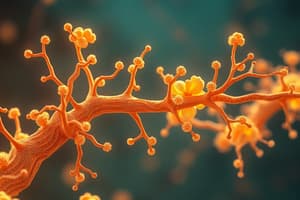Podcast
Questions and Answers
What is the primary mechanism for termination of noradrenaline (NA) at the nerve terminal?
What is the primary mechanism for termination of noradrenaline (NA) at the nerve terminal?
- Storage of NA in vesicles by an amine transporter system (VMAT2)
- Enzymatic degradation by COMT and MAO
- NA diffuses across the synapse to bind with adrenergic receptors
- Nerve terminal actively reuptakes NA (Uptake 1) (correct)
Which of the following drugs inhibits the Uptake 1 mechanism for termination of NA?
Which of the following drugs inhibits the Uptake 1 mechanism for termination of NA?
- Guanethidine
- Reserpine
- Cocaine and tricyclic antidepressants (TCAs) (correct)
- Amphetamine
What is the enzyme responsible for the conversion of dopamine to noradrenaline in the cytoplasm?
What is the enzyme responsible for the conversion of dopamine to noradrenaline in the cytoplasm?
- Dopamine-$\beta$-hydroxylase (correct)
- Tyrosine hydroxylase
- Catechol-O-methyltransferase (COMT)
- L-DOPA decarboxylase
Which of the following drugs inhibits the storage of noradrenaline in vesicles?
Which of the following drugs inhibits the storage of noradrenaline in vesicles?
What is the mechanism of action of guanethidine, a sympatholytic drug?
What is the mechanism of action of guanethidine, a sympatholytic drug?
Which of the following accurately describes the actions of alpha-1 (α1) receptors?
Which of the following accurately describes the actions of alpha-1 (α1) receptors?
Which receptor type is associated with the inhibition of noradrenaline release and insulin release from the pancreas?
Which receptor type is associated with the inhibition of noradrenaline release and insulin release from the pancreas?
Which receptor type is associated with chronotropic, inotropic, and dromotropic effects on the heart, as well as renin release from the kidney and lipolysis in fat cells?
Which receptor type is associated with chronotropic, inotropic, and dromotropic effects on the heart, as well as renin release from the kidney and lipolysis in fat cells?
Which of the following actions is NOT associated with beta-2 (β2) receptors?
Which of the following actions is NOT associated with beta-2 (β2) receptors?
Which receptor type is associated with the relaxation of the detrusor muscle of the bladder wall, leading to urinary retention, as well as glycogenolysis and gluconeogenesis in the liver?
Which receptor type is associated with the relaxation of the detrusor muscle of the bladder wall, leading to urinary retention, as well as glycogenolysis and gluconeogenesis in the liver?
Which of the following accurately describes the actions associated with the Gs receptor type?
Which of the following accurately describes the actions associated with the Gs receptor type?
Flashcards are hidden until you start studying
Study Notes
Termination of Noradrenaline (NA)
- Primary mechanism is the reuptake of NA into the nerve terminal, known as Uptake 1.
- This process decreases NA concentration in synaptic cleft, ending its action.
Drugs and Uptake Inhibition
- Some drugs inhibit the Uptake 1 mechanism, leading to increased levels of noradrenaline in synaptic cleft.
Conversion of Dopamine to Noradrenaline
- Enzyme responsible for this conversion in the cytoplasm is dopamine β-hydroxylase.
Inhibition of Noradrenaline Storage
- Certain drugs target the storage of noradrenaline in presynaptic vesicles, disrupting its availability for release.
Guanethidine Action
- Guanethidine acts as a sympatholytic drug, blocking the release of noradrenaline from sympathetic neurons.
Actions of Alpha-1 (α1) Receptors
- Alpha-1 receptors mediate vasoconstriction, increase peripheral resistance, and stimulate glycogenolysis.
Inhibition of Noradrenaline and Insulin Release
- Alpha-2 (α2) receptors are responsible for inhibiting both noradrenaline release and insulin secretion from the pancreas.
Beta-1 and Beta-2 Receptor Effects
- Beta-1 (β1) receptors are linked with increasing heart rate (chronotropic), myocardial contractility (inotropic), and conduction velocity (dromotropic), alongside stimulating renin release and promoting lipolysis.
Actions NOT Associated with Beta-2 (β2) Receptors
- Certain effects, like increased contraction of smooth muscle, are NOT associated with β2 receptor activation.
Detrusor Muscle Relaxation and Glycogenolysis
- Beta-3 (β3) receptors are linked with relaxation of the detrusor muscle in the bladder, promoting urinary retention, as well as facilitating glycogenolysis and gluconeogenesis in the liver.
Gs Receptor Type Actions
- Gs receptor type is involved in stimulating adenylyl cyclase, increasing cyclic AMP (cAMP) levels, and enhancing protein kinase A (PKA) activity, leading to various cellular responses.
Studying That Suits You
Use AI to generate personalized quizzes and flashcards to suit your learning preferences.





